
WWII GLIDER PILOT
Gerald Hector Galarneau
2nd Lt, Flight officer
44th Troop Carrier Squadron
316th Troop Carrier Group
Serial # 15081426
Gerald Galarneau enlisted as a Pivate in the Army Air Corps on May 30, 1942 at the Greenville Army Air Force Base in Mississippi. His enlistment shows him as single and without dependents having completed 4 years college with his previous occupation under the "Bookkeepers and cashiers, except bank cashiers" category.
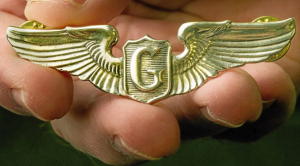 His training started at Greenville Army Air Forces Pilot Training School and continued at the advanced glider school at Victorville Army Air Field in California (opened late 1942). It was while training at Victorville that he had the glider crash where he as co-pilot and the pilot bailed out. He wrote about this incident in his essay "Infinite Love" and it was an experience that shaped his life and made him the person he became. He first deployed to North Africa in 1943 joining the 316th already there. He shipped over on a troop transport and had duty to watch over troops billeted in the ship's hold. He told the story of how he was given a gun and authority. Before finishing his tour of duty he spent time in North Africa, Italy, England, France and Holland. He wrote another one of his WWII essays on his experience during the Market Garden operation in Holland that sheds light on this period of his life.
His training started at Greenville Army Air Forces Pilot Training School and continued at the advanced glider school at Victorville Army Air Field in California (opened late 1942). It was while training at Victorville that he had the glider crash where he as co-pilot and the pilot bailed out. He wrote about this incident in his essay "Infinite Love" and it was an experience that shaped his life and made him the person he became. He first deployed to North Africa in 1943 joining the 316th already there. He shipped over on a troop transport and had duty to watch over troops billeted in the ship's hold. He told the story of how he was given a gun and authority. Before finishing his tour of duty he spent time in North Africa, Italy, England, France and Holland. He wrote another one of his WWII essays on his experience during the Market Garden operation in Holland that sheds light on this period of his life.
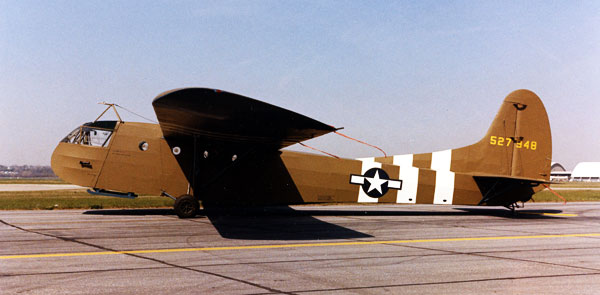 The WACO glider, designated the CG-4A, “C” for cargo and “G” for Glider, would become the mainstay in the Air Corps glider fleet. As a utility glider it performed its mission well. It not only transported infantry troops, but it also carried weapons, vehicles and cargo urgently needed by paratroopers fighting the enemy. The big glider had none of the soaring capabilities of the high performance sailplane. With a sink rate of 950 feet per minute at 100 mph, there was only one way for the CG-4A to go after release and that was down.
The CG-4A glider was a high-wing, strut-braced monoplane built of steel tubing, plywood and aircraft fabric. It was designed to carry a pilot and a copilot, seated side by side, and thirteen glider infantrymen or cargo, for a gross load of 7,500 pounds.
The WACO glider, designated the CG-4A, “C” for cargo and “G” for Glider, would become the mainstay in the Air Corps glider fleet. As a utility glider it performed its mission well. It not only transported infantry troops, but it also carried weapons, vehicles and cargo urgently needed by paratroopers fighting the enemy. The big glider had none of the soaring capabilities of the high performance sailplane. With a sink rate of 950 feet per minute at 100 mph, there was only one way for the CG-4A to go after release and that was down.
The CG-4A glider was a high-wing, strut-braced monoplane built of steel tubing, plywood and aircraft fabric. It was designed to carry a pilot and a copilot, seated side by side, and thirteen glider infantrymen or cargo, for a gross load of 7,500 pounds.
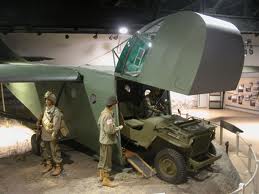 The nose of the CG-4A was hinged at the top so that it could be raised for loading cargo. Two mahogany plywood bench seats could be installed along each side, and a single fold-down seat was mounted at the left rear entrance, to accommodate thirteen fully equipped glider infantrymen. Entrance doors were provided on both sides of the aft section of the cargo section sufficiently wide for a fully armed man to walk through with ease. Emergency exits were located on each side of the fuselage under the wings. The glider infantrymen were issued Mae West life jackets but not parachutes. When a jeep was carried, all four bench seats had to be removed.
The CG-4A was not designed to be a thing of beauty - and certainly it was not considered to be an attractive aircraft. Most Air Force power pilots joked about its ungainly appearance but few of them poked any funny remarks at the guys who flew them. The glider pilots were an independent, tough, ready-to-fight group of pilots and they certainly were not backward in letting anyone know that the "G" on their silver wings stood for "Guts."
The nose of the CG-4A was hinged at the top so that it could be raised for loading cargo. Two mahogany plywood bench seats could be installed along each side, and a single fold-down seat was mounted at the left rear entrance, to accommodate thirteen fully equipped glider infantrymen. Entrance doors were provided on both sides of the aft section of the cargo section sufficiently wide for a fully armed man to walk through with ease. Emergency exits were located on each side of the fuselage under the wings. The glider infantrymen were issued Mae West life jackets but not parachutes. When a jeep was carried, all four bench seats had to be removed.
The CG-4A was not designed to be a thing of beauty - and certainly it was not considered to be an attractive aircraft. Most Air Force power pilots joked about its ungainly appearance but few of them poked any funny remarks at the guys who flew them. The glider pilots were an independent, tough, ready-to-fight group of pilots and they certainly were not backward in letting anyone know that the "G" on their silver wings stood for "Guts."
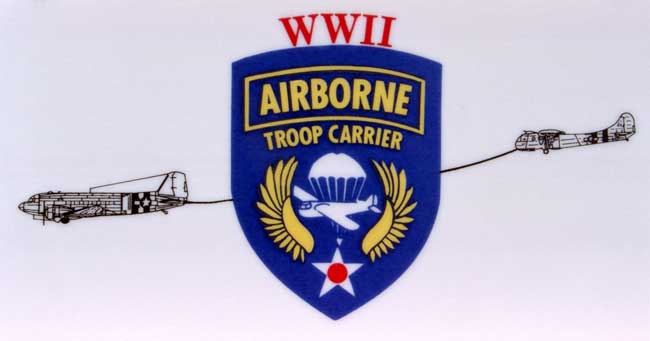 The 316th Troop Carrier Group, formed at Patterson Field, Ohio in early 1942, and
consisted of Headquarters, 36th, 37th, 44th, and 45th Squadrons. Deployed to Egypt in November 1942 as part of President Roosevelt's decision to aid the Royal Air Force Western Desert Air Force, assigned to the newly-established Ninth Air Force, headquartered in Cairo. The group in North Africa flew C-47s in support of the British
8th Army across North Africa from Egypt to Tunisia, delivering supplies and pioneering in air evacuation. In July 1943 the Group dropped the 82nd Airborne Division into Sicily (operations HUSKY 1 and 2). In February 1944, the 316th moved to Cottesmore, England, its base for participating in the invasions of France (Normandy, D-Day), Holland (MARKET GARDEN), and Germany (VARSITY). After 30 months of overseas duty, the 316th Troop Carrier Group returned to the US in May 1945.
The 316th Troop Carrier Group, formed at Patterson Field, Ohio in early 1942, and
consisted of Headquarters, 36th, 37th, 44th, and 45th Squadrons. Deployed to Egypt in November 1942 as part of President Roosevelt's decision to aid the Royal Air Force Western Desert Air Force, assigned to the newly-established Ninth Air Force, headquartered in Cairo. The group in North Africa flew C-47s in support of the British
8th Army across North Africa from Egypt to Tunisia, delivering supplies and pioneering in air evacuation. In July 1943 the Group dropped the 82nd Airborne Division into Sicily (operations HUSKY 1 and 2). In February 1944, the 316th moved to Cottesmore, England, its base for participating in the invasions of France (Normandy, D-Day), Holland (MARKET GARDEN), and Germany (VARSITY). After 30 months of overseas duty, the 316th Troop Carrier Group returned to the US in May 1945.
Sicily Mission
9-12 July 1943
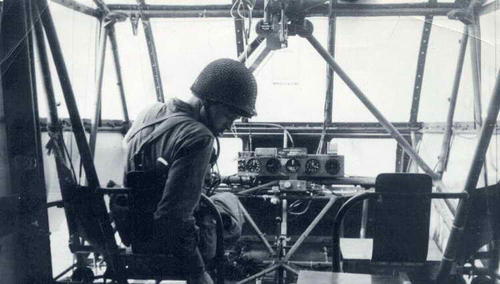 Operation Ladbroke, the invasion of Sicily, was a nighttime British glider mission, contrary to the fact that night flying training was not part of the British glider doctrine. Members of the British Glider Pilot Regiment would fly American Waco CG-4A gliders with a few American volunteer glider pilots as copilots. Pre-mission training in the Waco consisted of 4½ hours 1½ hours of it at night. M/G Matthew B. Ridgeway, CO of the 82nd Airborne Division, cabled B/G Maxwell Taylor in North Africa, before the scheduled mission, urging him to persuade General Dwight Eisenhower’s planners to change the mission from night to early dawn. His plea failed. By 13 June 1943, 346 of the 500 CG-4As shipped to Africa that March had been assembled by glider pilots and others. Only 136 of the 300 were used for Operation Ladbroke which also included 8 British Horsas, 111 C47s, 25 British Albemarles and 8 Halifax bombers. 42 American glider pilots volunteered to train the British glider pilots in the CG-4A, but it is believed that only 19 of them flew as copilots on the Sicily mission. The Americans who flew the mission were placed on detached service to the British Glider Pilot Regiment. The 144 gliders participating in Operation Ladbroke were towed from six Tunisian airfields beginning at 1842 hours on 9 July 1943 by C-47s and C-53s of the 51st Troop Carrier Wing. Shortly after takeoff six tow planes turned back because of shifting loads in gliders, another turned back when the jeep it was carrying broke loose from its tie downs. Further into the mission when the formation ran into extremely turbulent winds three gliders broke loose from their tow plane and vanished with all hands. Two other tow planes became lost and returned to Tunisia. High winds at the release point coupled with inexperienced tow pilots led to 69 gliders being released too far from shore and were unable to make landfall. 605 officers and men were lost, 326 presumed to have drowned. Only 49 CG-4As and 5 Horsas landed on Sicilian soil within a 10 mile radius of their landing zones. Allegedly, only 5 CG-4As and 2 British Horsa gliders actually landed on their designated LZs (Landing Zones). To make matters worse, eleven American C-47s and C-53s filled with paratroopers were mistakenly shot out of the sky by friendly Allied ships participating in the invasion. American Major General Joseph M. Swing, cited five major mission weaknesses; (1) Insufficient time spent in coordinating the air routes with all forces, (2) Complexity of the flight route and the low degree of training for the navigators, (3) The rigid naval policy of firing at any and all aircraft, (4) The unfortunate timing of the airdrops directly after extensive enemy air attacks, and (5) The failure of some army ground commanders to warn all antiaircraft gun units of the impending airborne missions. Six (6) American glider pilots were killed. In spite of the many difficulties all of the objectives were taken and the mission was considered a success. In his report to General Eisenhower, General “Boy” Browning placed all the blame on American Troop Carrier crews.
Operation Ladbroke, the invasion of Sicily, was a nighttime British glider mission, contrary to the fact that night flying training was not part of the British glider doctrine. Members of the British Glider Pilot Regiment would fly American Waco CG-4A gliders with a few American volunteer glider pilots as copilots. Pre-mission training in the Waco consisted of 4½ hours 1½ hours of it at night. M/G Matthew B. Ridgeway, CO of the 82nd Airborne Division, cabled B/G Maxwell Taylor in North Africa, before the scheduled mission, urging him to persuade General Dwight Eisenhower’s planners to change the mission from night to early dawn. His plea failed. By 13 June 1943, 346 of the 500 CG-4As shipped to Africa that March had been assembled by glider pilots and others. Only 136 of the 300 were used for Operation Ladbroke which also included 8 British Horsas, 111 C47s, 25 British Albemarles and 8 Halifax bombers. 42 American glider pilots volunteered to train the British glider pilots in the CG-4A, but it is believed that only 19 of them flew as copilots on the Sicily mission. The Americans who flew the mission were placed on detached service to the British Glider Pilot Regiment. The 144 gliders participating in Operation Ladbroke were towed from six Tunisian airfields beginning at 1842 hours on 9 July 1943 by C-47s and C-53s of the 51st Troop Carrier Wing. Shortly after takeoff six tow planes turned back because of shifting loads in gliders, another turned back when the jeep it was carrying broke loose from its tie downs. Further into the mission when the formation ran into extremely turbulent winds three gliders broke loose from their tow plane and vanished with all hands. Two other tow planes became lost and returned to Tunisia. High winds at the release point coupled with inexperienced tow pilots led to 69 gliders being released too far from shore and were unable to make landfall. 605 officers and men were lost, 326 presumed to have drowned. Only 49 CG-4As and 5 Horsas landed on Sicilian soil within a 10 mile radius of their landing zones. Allegedly, only 5 CG-4As and 2 British Horsa gliders actually landed on their designated LZs (Landing Zones). To make matters worse, eleven American C-47s and C-53s filled with paratroopers were mistakenly shot out of the sky by friendly Allied ships participating in the invasion. American Major General Joseph M. Swing, cited five major mission weaknesses; (1) Insufficient time spent in coordinating the air routes with all forces, (2) Complexity of the flight route and the low degree of training for the navigators, (3) The rigid naval policy of firing at any and all aircraft, (4) The unfortunate timing of the airdrops directly after extensive enemy air attacks, and (5) The failure of some army ground commanders to warn all antiaircraft gun units of the impending airborne missions. Six (6) American glider pilots were killed. In spite of the many difficulties all of the objectives were taken and the mission was considered a success. In his report to General Eisenhower, General “Boy” Browning placed all the blame on American Troop Carrier crews.
Holland Mission
17-23 September 1944
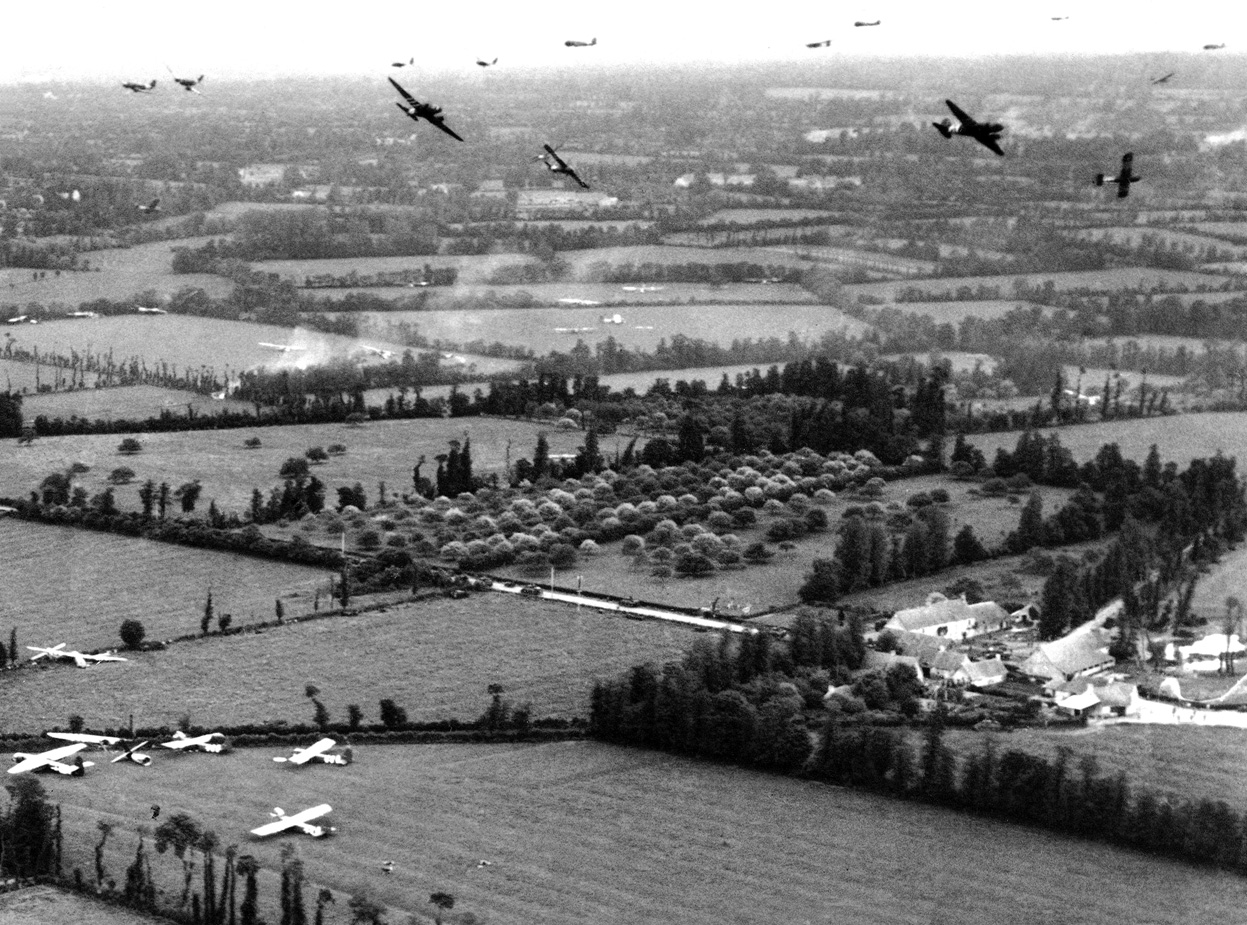 More gliders were used in Operation Market, the airborne phase of Operation Market-Garden, the invasion of Holland, than any other World War II glider mission. A total of 1899 CG-4As participated in the Operation, and 1618 of them landed safely. The American objective was to take and hold the bridges from Eindhoven to Nijmegen so the
More gliders were used in Operation Market, the airborne phase of Operation Market-Garden, the invasion of Holland, than any other World War II glider mission. A total of 1899 CG-4As participated in the Operation, and 1618 of them landed safely. The American objective was to take and hold the bridges from Eindhoven to Nijmegen so the
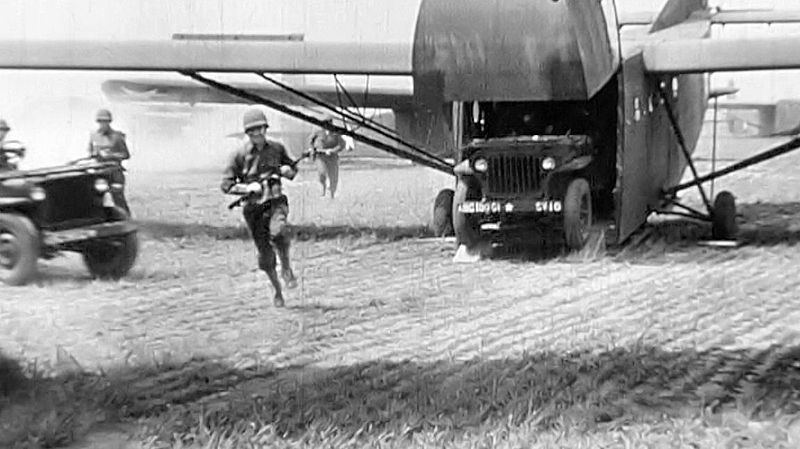 British XXX Corps could speed to Arnhem with its tanks and ground forces. There were not enough American glider pilots in the theater to provide copilots, so untrained glider troopers occupied the right seat. To meet minimum needs an additional 150 glider pilots were flown in from the states just days before D-Day. 70 CG-4As from the airfield at Chilbolton, England, took off behind C-47s of the 437th Troop Carrier Group at 1110 hours on 17
September 1944 and headed for Holland. Two minutes later, 50 CG-4As towed behind C-47s of the 439th Troop Carrier Group took off from an airfield at Balderton, England. The following day, 18 September, 450 CG-4As were towed behind C-47s from airfields at Aldermaston, Welford, Membury, Chilbolton, Greenham Common and an unnamed airfield, beginning at 1120 hours. Eleven minutes earlier, 454 CG-4A took off behind C-47s of the 61st, 313th, 316th, 439th, 440th and 441st Troop Carrier Groups and headed for Holland. Beginning at 1437 hours on 19 September 1944, 385 CG-4As departed airfields at Aldermaston, Welford, Membury, Chilbolton, and Greenham Common and headed for their respective landing zones. On D-Day plus 3, 20 September, only one CG-4A from the 53rd Troop Carrier Wing was towed to Holland, departing from an unnamed airfield at 1430 hours. Three days later, beginning at 1200 hours, 84 CG-4As from the 436th TCG at Membury and the 438th TCG at Greenham Common were towed to Holland by C-47s. That same day,
British XXX Corps could speed to Arnhem with its tanks and ground forces. There were not enough American glider pilots in the theater to provide copilots, so untrained glider troopers occupied the right seat. To meet minimum needs an additional 150 glider pilots were flown in from the states just days before D-Day. 70 CG-4As from the airfield at Chilbolton, England, took off behind C-47s of the 437th Troop Carrier Group at 1110 hours on 17
September 1944 and headed for Holland. Two minutes later, 50 CG-4As towed behind C-47s of the 439th Troop Carrier Group took off from an airfield at Balderton, England. The following day, 18 September, 450 CG-4As were towed behind C-47s from airfields at Aldermaston, Welford, Membury, Chilbolton, Greenham Common and an unnamed airfield, beginning at 1120 hours. Eleven minutes earlier, 454 CG-4A took off behind C-47s of the 61st, 313th, 316th, 439th, 440th and 441st Troop Carrier Groups and headed for Holland. Beginning at 1437 hours on 19 September 1944, 385 CG-4As departed airfields at Aldermaston, Welford, Membury, Chilbolton, and Greenham Common and headed for their respective landing zones. On D-Day plus 3, 20 September, only one CG-4A from the 53rd Troop Carrier Wing was towed to Holland, departing from an unnamed airfield at 1430 hours. Three days later, beginning at 1200 hours, 84 CG-4As from the 436th TCG at Membury and the 438th TCG at Greenham Common were towed to Holland by C-47s. That same day,
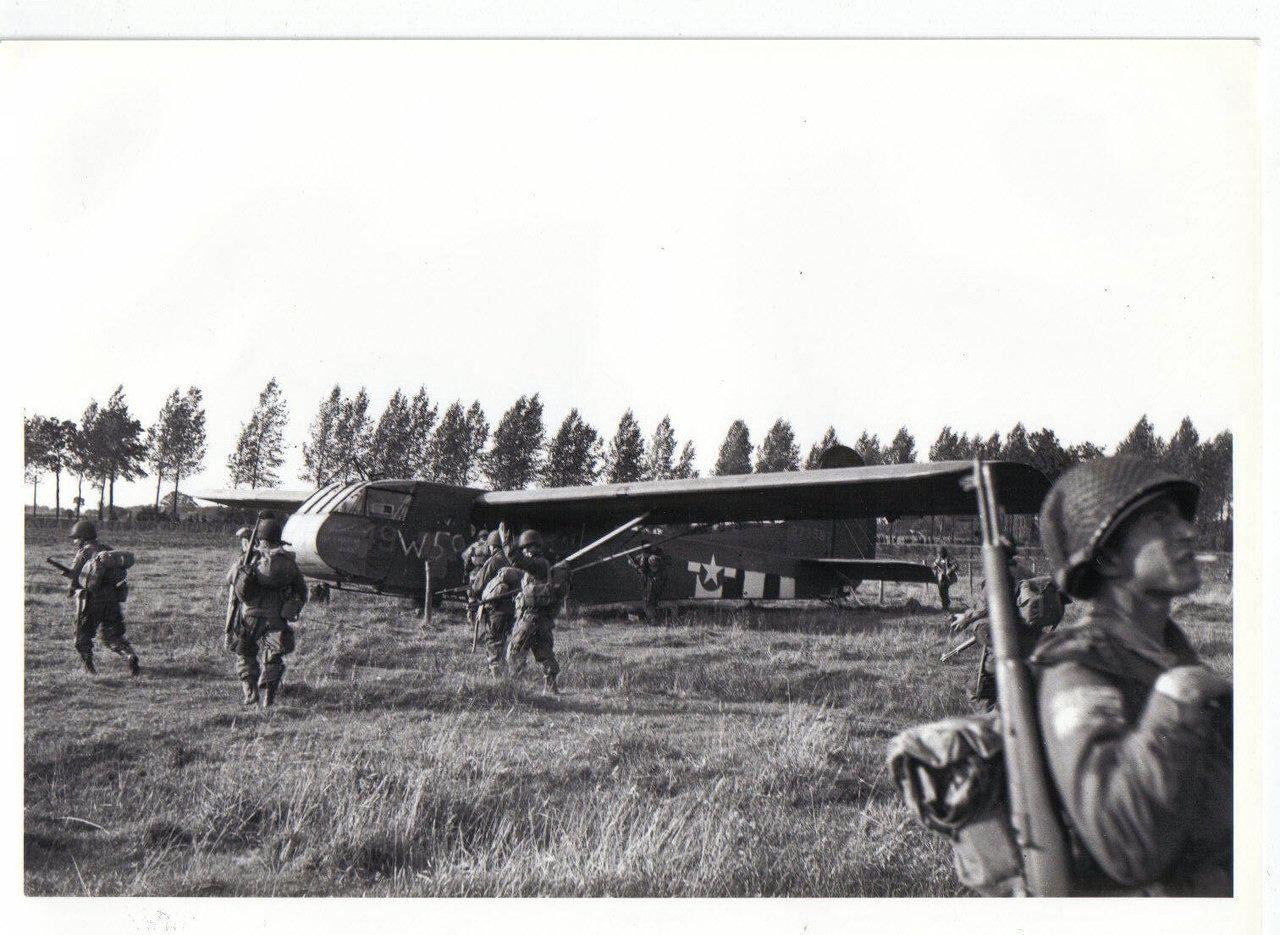 23 September, 406 CG-4As towed by C-47s of the 61st, 313th, 316th and 434th Troops Carrier Groups from airfields at Barkston Heath, Folkingham, Cottesmore and Chilbolton respectively took off beginning at 1210 hours headed for their assigned landing zones. 101st Airborne Division glider landings near Eindhoven were made on Landing Zone (LZ) “W”, an expansive landing area. It was 1½ miles north of Zon and west of the north-south main road from Eindhoven. The 82nd Airborne Division glider landings near Nijmegen were on LZ “T” and LZ “N”, which were joined together in an oblong shape, 3½ miles long north to south and 1½ miles long east to west. Nine gliders towed by the 61st Troop Carrier Group to LZ “T” were mistakenly towed 12 miles into Germany, east-southeast of LZ “T”. They were never seen
23 September, 406 CG-4As towed by C-47s of the 61st, 313th, 316th and 434th Troops Carrier Groups from airfields at Barkston Heath, Folkingham, Cottesmore and Chilbolton respectively took off beginning at 1210 hours headed for their assigned landing zones. 101st Airborne Division glider landings near Eindhoven were made on Landing Zone (LZ) “W”, an expansive landing area. It was 1½ miles north of Zon and west of the north-south main road from Eindhoven. The 82nd Airborne Division glider landings near Nijmegen were on LZ “T” and LZ “N”, which were joined together in an oblong shape, 3½ miles long north to south and 1½ miles long east to west. Nine gliders towed by the 61st Troop Carrier Group to LZ “T” were mistakenly towed 12 miles into Germany, east-southeast of LZ “T”. They were never seen
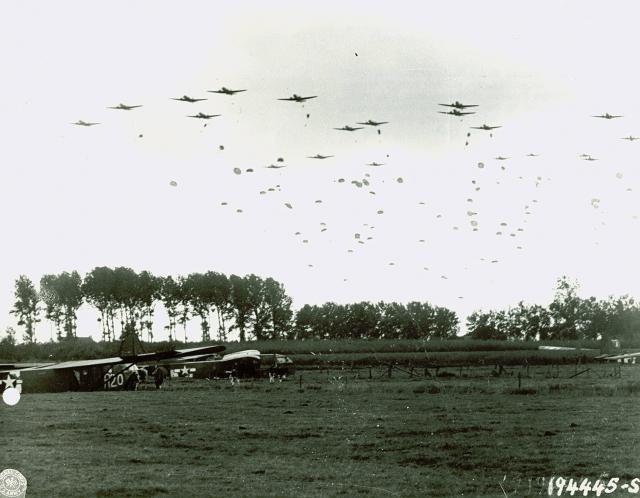 again. Of the 1899 gliders used in Operation Market only 281 were salvaged. An additional 118 salvageable gliders were destroyed in a storm before they could be recovered. Several military sources stated that as many as 700 of the gliders were equipped with the bolt-on Griswold nose or the protective Corey Skid, and as many as 900 were fitted with the 8 foot deceleration parachute. According to the Membership Roster of the National World War II Glider Pilot Association forty (40) glider pilots were killed in action in Holland between 17 and 23 September 1944. Seven glider pilots were killed on 17 September1944, thirteen (13) on 18 September, fifteen (15) on 19 September, one (1) on 20 September, one (1) on 21 September and three (3) on 23 September. As many as 123 glider pilots were wounded or injured in action. Some were captured by the Germans and became prisoners of war. The Americans took all of their objectives, but the British failed to take Arnhem.
again. Of the 1899 gliders used in Operation Market only 281 were salvaged. An additional 118 salvageable gliders were destroyed in a storm before they could be recovered. Several military sources stated that as many as 700 of the gliders were equipped with the bolt-on Griswold nose or the protective Corey Skid, and as many as 900 were fitted with the 8 foot deceleration parachute. According to the Membership Roster of the National World War II Glider Pilot Association forty (40) glider pilots were killed in action in Holland between 17 and 23 September 1944. Seven glider pilots were killed on 17 September1944, thirteen (13) on 18 September, fifteen (15) on 19 September, one (1) on 20 September, one (1) on 21 September and three (3) on 23 September. As many as 123 glider pilots were wounded or injured in action. Some were captured by the Germans and became prisoners of war. The Americans took all of their objectives, but the British failed to take Arnhem.
44th Transport Squadron
History
Activated on 15 June 1942 under First Air Force, being formed at Patterson Field, Ohio and redesignated 44th Troop Carrier Squadron on 4 Jul 1942. Trained at various stations in the southeast and Texas with C-47 Skytrain transports. Deployed to Egypt in November 1942 as part of President Roosevelt's decision to aid the Royal Air Force Western Desert Air Force, assigned to the newly-established Ninth Air Force, headquartered in Cairo.
Transported supplies and evacuated casualties in support of the British Eighth Army, operating from desert airfields in Egypt and Libya. Reassigned in May 1943 to the USAAF Twelfth Air Force in Algeria, supporting Fifth Army forces in the Tunisian Campaign. Began training for the invasion of Sicily; dropped paratroops over the assault area on the night of 9 July. Carried reinforcements to Sicily on 11 July and received a DUC for carrying out that mission although severely attacked by ground and naval forces; dropped paratroops over the beachhead south of the Sele River on the night of 14 Sep 1943. Remained in the MTO until February 1944 until being reassigned back to Ninth Air Force in England, IX Troop Carrier Command to participate in the buildup of forces prior to the Allied landings in France during D-Day in June 1944.
Engaged in combat operations by dropping paratroops into Normandy near Ste-Mere-Eglise on D-Day (6 June 1944) and releasing gliders with reinforcements on the following day. The unit received a third Distinguished Unit Citation and a French citation for these missions.
After the Normandy invasion the squadron ferried supplies in the United Kingdom. The squadron also hauled food, clothing, medicine, gasoline, ordnance equipment, and other supplies to the front lines and evacuated patients to rear zone hospitals. It dropped paratroops near Nijmegen and towed gliders carrying reinforcements during the airborne attack on Holland. In December, it participated in the Battle of the Bulge by releasing gliders with supplies for the 101st Airborne Division near Bastogne.
Was Inactivated 5 May 1946 and returned to the United States in May 1942
Operations and Decorations
Combat Operations.
Included airborne assaults on Sicily, Normandy, Holland, and Germany;
aerial transportation of personnel (including casualties), supplies, and equipment in the Mediterranean Theater of Operations (MTO) and European Theater of Operations (ETO), Nov 1942-Apr 1945.
Campaigns. World War II: Egypt-Libya; Tunisia; Sicily; Naples-Foggia; Rome-Arno; Normandy; Northern France; Rhineland; Central Europe.
Decorations. Distinguished Unit Citations: Egypt, Libya, Tunisia, Sicily, 25 Nov 1942-25 Aug 1943; Sicily, 11 Jul 1943; France, [6-7] Jun 1944.
Stations
| Patterson Field, Ohio | 15 Jun 1942 |
| Bowman Field, Kentucky | 16 Jun 1942 |
| Lawson Field, Georgia | 09 Aug 1942 |
| Del Valle Army Airbase, Texas | 29 Sep-10 Nov 1942 |
| RAF Deversoir, Egypt | 23 Nov 1942 |
| RAF El Adem, Egypt | 10 Dec 1942 |
| RAF Fayid, Egypt | Jan 1943 |
| Nouvion Airfield, Algeria | 10 May 1943 |
| Guercif Airfield, French Morocco | 28 May 1943 |
| Enfidaville Airfield, Tunisia | 24 Jun 1943 |
| Mazzara Airfield, Sicily | Mazzara Airfield, Sicily, 01 Sep 1943 |
| Borizzo Airfield, Sicily | 18 Oct 1943-16 Feb 1944 |
| RAF Cottesmore, England | Feb 1944-May 1945 |
| Pope Field, North Carolina | May 1945 |